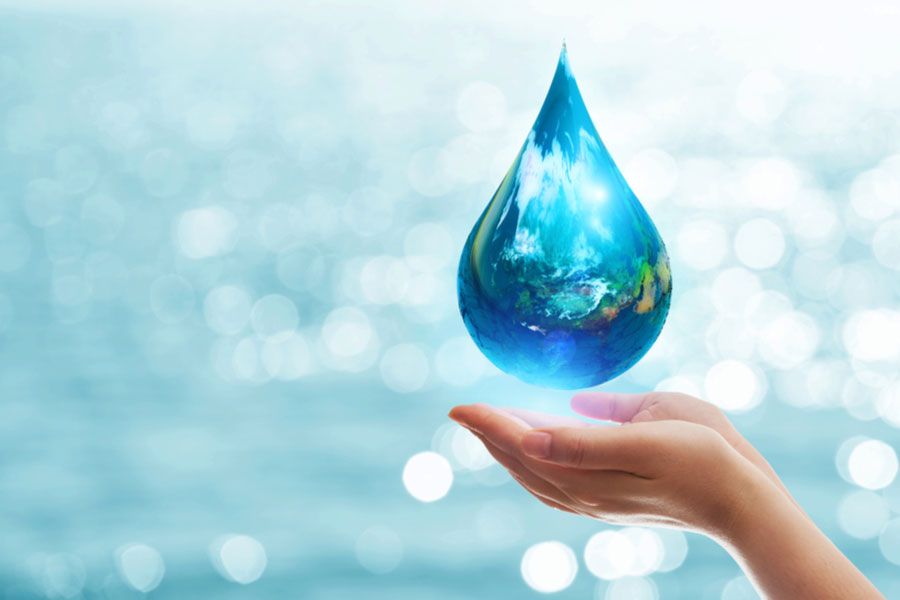Gujarat: A model state in water management
Home to 17% of the world’s population, India is endowed with only 4% fresh water resources. This mismatch creates a serious challenge: meeting the population’s needs while attaining economic growth sustainably. However, there’s one Indian state which has managed to overcome its water woes successfully – Gujarat. This blog explores the inspiration that other states can draw from it.
- Water is an imperative resource for all forms of life. However, in its pursuit for progress, human race forgot that this God’s gift to mankind is ultimately finite & now depleting.
- Like the rest of the world, India is also grappling with the scarcity of water. What makes this non-renewable resource dearer for the economy is the fact that water mismanagement could curtail its GDP by nearly 6% by 2050.
- However, Gujarat is an inspiring case study of a state that has managed to overcome its water woes successfully. Today, it is ranked first in terms of its water management practices in the country.
- The success story of Gujarat shows that a tripartite collaboration between the government, the private sector and individuals is critical to conserve this dwindling resource.

Source: Shutterstock
Water = gold in the 21st century!
That water is the building block of life is a universally recognized fact. Be it cooking, cleaning, cultivating crops or carrying out industrial activities – water is an inevitable resource for all forms of daily life. However, in its pursuit for progress, human race forgot that this God’s gift to mankind is ultimately a finite resource that is now, unfortunately, already beginning to deplete in certain parts of the world. And India is no exception to this! Home to 17% of the world’s population, India is endowed with only 4% of the planet’s fresh water resources. This mismatch of demand and supply of water creates a serious challenge for India: meeting the needs of its population (e.g., food security) while attaining economic growth & development in a sustainable manner.
The World Bank notes that despite a looming water scarcity, India is sadly the largest net exporter of virtual water (the amount of water required to produce the products that India exports). It adds that India is one of the most water-intense economies and is one of the largest water users per unit of gross domestic product (GDP). What makes this non-renewable resource dearer for the economy is the fact that water mismanagement could curtail India’s GDP by nearly 6% by 2050. Similarly, NITI Aayog states that the annual per capita water availability is expected to reduce to 1,140 cubic metres by 2050. However, there’s one Indian state that has stood out when it comes to overcoming its water woes successfully and emerge as an epitome in water management – Gujarat. This blog explores the lessons that other Indian states can draw from it without compromising on their economic growth.
Gujarat: From ground zero to rank 1
With only 2% of the country’s water resources and 5% of the country’s population, Gujarat is typically reckoned as a water deficient state. Its rocky terrain and coastal topography make ground water withdrawal unfeasible, while the supply of surface water is limited. This is due to the fact that it lies on the leeward side of the Western Ghats and by the time, the Bay of Bengal branch of the South West Monsoon reaches Gujarat, it does not have adequate moisture left with to cause rain. It is known to receive less than 60 cm of rainfall annually.
Paradoxically though, Gujarat ranked first in water management in NITI Aayog’s 2019 edition of the Composite Water Management Index. This is the third year in a row that the state has managed to retain the top spot in the ranking. This is attributed to the serious efforts made by Gujarat in all the important areas of water sector such as source augmentation, source management and distribution management through reduction of dependence on the scarce ground water resources.
One such noteworthy initiative by the Gujarat government is the Sujalam Sufalam Yojana, a water conservation scheme by the Gujarat government. The scheme revolves around the twin objectives of deepening of water bodies before monsoons and enhancing water storage for rainwater collection. It entails desilting of water bodies across the state through a participative approach. In its first year (2018), the scheme succeeded in achieving the targets of increasing water storage capacity by 11,000 lakh cubic feet through deepening of 13,000 lakes, check dams, and reservoirs. On the back of this success, the state earmarked its financial contribution to 60% for programme activities, requiring private entities to pay only the remaining 40%.
Gujarat also has a few lessons to offer in micro-irrigation. The state established a special purpose vehicle – Gujarat Green Revolution Company – which educated the farmers in adoption of scientific water management techniques and benefits of value-addition in crop production and marketing of their produces. In this endeavour, it embarked upon Jal Sanchay Abhiyan, a drive for storage of water which revolved around micro-irrigation. All those farmers who complied with this initiative were provided electricity connections on a priority basis. In total, 6, 40,853 farmers in Gujarat adopted Micro Irrigation Systems (MIS) in a total area of 10, 34,930 Ha. The scheme showed that strict monitoring and dedicated agencies played a crucial role in making the programme a success.
Another benchmark initiative by the state is a water management system that injects and stores excess rainfall water underground and later uses it for irrigation during summers. This programme, Bhungroo, was carried out by a number of Gram Panchayats. It encompassed training farmers in installation of sub-surface storage and a piezometer for water level monitoring on a day-to- day basis. By augmenting ground water through harvesting water on around 10 rainy days, farmers were able to continue farming for more than half of the year. Not only did this programme contribute towards establishing food security and improving the state’s agricultural output, it also reduced drudgery of women, thus making them the chief owner and expert of this practice.
Another innovative programme that the state experimented with was the Swajaldhara program in the Chinchojhar village. As a part of this initiative, a collection tank was built near a perennial spring at a height of 120 meters from the main village. A storage tank with 10,000 liters capacity was also constructed to provide water to the village. This intervention increased the sources of water available to the villagers, who previously had access to only one open well.
Sitting on a time bomb: The clock of water management is ticking fast
To sum up, water is today’s liquid gold and the country needs to use this priceless resource judiciously, if it does not want to sabotage the needs of its population in the future or its economic growth. In this context, it needs a tripartite collaboration between the government, the private sector and individuals to conserve this dwindling resource. This is evident from Gujarat, a water deficient state that is numero uno in terms of water management. This state has proved that with a little bit of training, awareness and application of scientific techniques, a lot of water can be conserved. But as mentioned, governments need to rope in the private sector and the civil society collectively to ensure that this happens.













Leave a comment